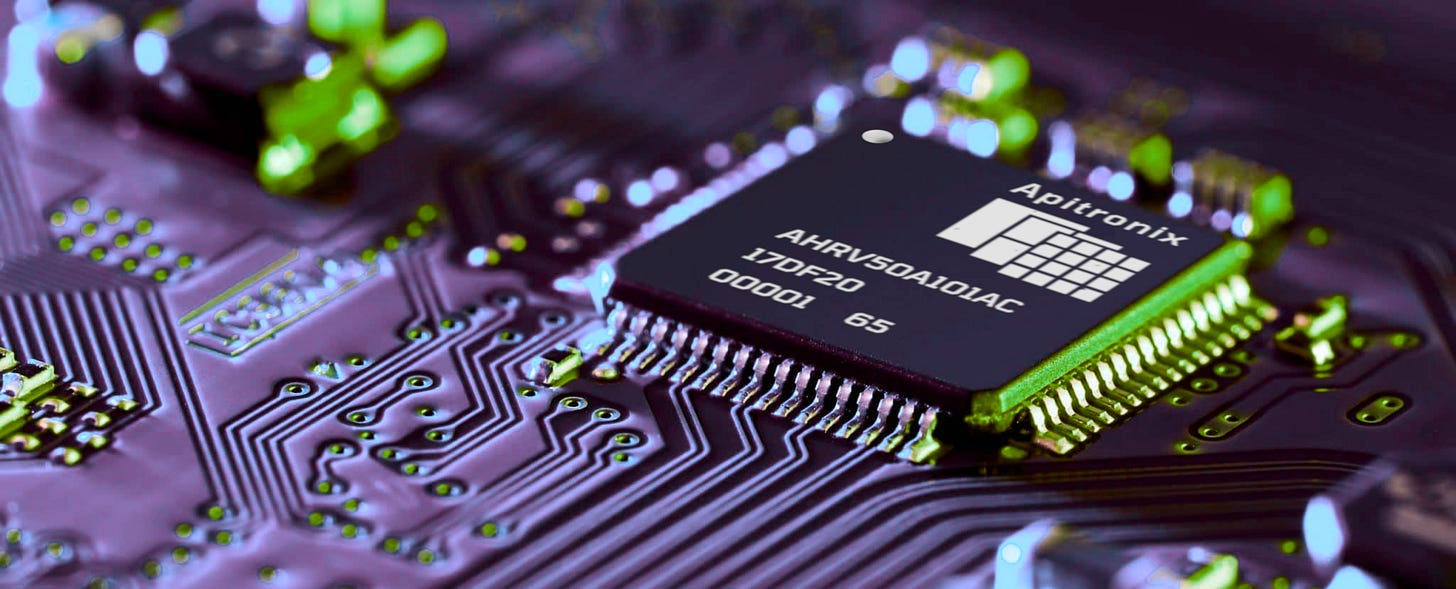Apitronix Aims to Revolutionize Embedded Systems with Innovative 'Tasklet' Chip Design
UK Semiconductor Starup Series - 2
Apitronix Semiconductor, a UK-based startup established in 2024, is aiming to disrupt the embedded systems industry with its groundbreaking approach to processor design.
In a recent interview with TechSoda, Ed French, CEO of Apitronix, shared the company's vision and the innovative technology driving its development.
The inspiration for Apitronix stemmed from a deep understanding of the inefficiencies plaguing current embedded systems. French's colleague, with a background in embedded systems, observed that sometimes as much as a staggering 95% of the computational capacity of chips was being consumed by operating system overhead and task synchronization, leaving a mere 5% for useful computation.
French explained, “We realized the industry isn't going to do this on their own. This is a radical change, because you can only change the way the software works by having new hardware. And so, if we wanted this to happen, we’d have to make the chip.”
This stark realization sparked the idea for Apitronix – to create a chip that fundamentally changes how software operates in embedded systems.
Tasklet: A Novel Approach to Chip Architecture
Apitronix's core innovation lies in its "tasklet" architecture, inspired by the modular and parallel nature of the human brain. Unlike conventional systems that often rely on separate chips for real-time motor control, Apitronix's tasklets operate independently and predictably. This deterministic behavior ensures that critical functions—like motor control—are never disrupted by other processes. As a result, developers can eliminate external ICs, reducing both system complexity and product cost by integrating everything into a single, real-time central processor.
Traditional chips often struggle to efficiently utilize multiple cores due to coordination overhead. In contrast, Apitronix uses a message-passing architecture powered by its proprietary "MessagePrism" system. The chip features 220 ultra-small RISC-V cores, each communicating through pre-defined, deterministic channels governed by contracts. This ensures guaranteed timing and performance while safeguarding against malware, security breaches, and supply chain attacks by isolating and controlling inter-core interactions.
Advantages of Tasklet Architecture
The tasklet architecture provides several key advantages over traditional chip designs. Its massively parallel structure delivers significantly greater computational power, enabling high-performance processing across a broad range of applications. The underlying message-passing system reduces coordination overhead, ensuring efficient real-time execution. Security is inherently strengthened through a contract-based communication model, which isolates tasklets and blocks unauthorized interactions. This design also streamlines software development by allowing developers to implement straightforward software models without the need for complex optimization. Despite its high core count, the architecture is highly energy-efficient—power is conserved by keeping inactive cores off and by eliminating energy-intensive mechanisms like branch prediction.
A senior semiconductor industry expert that TechSoda consulted compared Apitronix Tasklet Processor and traditional Microcontroller Units (MCUs) with a Real-Time Operating System (RTOS) across five key features. The Apitronix processor generally excels in real-time performance, scalability, modularity, and integration, offering high capabilities in these areas. It achieves high real-time performance by assigning each task to its own core, enabling scaling by adding more tasklets to more cores, fostering modularity through plug-and-play tasklets, and simplifying integration by replacing the MCU and RTOS with a single chip.
In contrast, traditional MCUs with RTOS are rated moderate to low in these categories, requiring careful tuning for real-time performance, having limited scalability due to fewer cores, employing monolithic or tightly coupled code, and potentially needing extra chips or complex software for integration. However, traditional MCUs + RTOS hold an advantage in ease of development due to their use of familiar tools and programming styles, whereas the Apitronix processor is considered moderate due to its new model, despite not requiring management of threads or interrupts.
Target Verticals and Applications
French shared that Apitronix is targeting several key verticals for its technology:
Automotive: The automotive industry is facing increasing pressure to reduce time to market and manage the complexity of centralized computing. Apitronix's solution can significantly accelerate development cycles and improve the reliability and security of vehicle software.
Defense: The defense sector also demands agility and rapid iteration. Apitronix's technology enables swift implementation of control models for applications like UAVs, reducing development time and ensuring real-time performance.
General Consumer Electronics, White Goods, and IoT: Apitronix sees potential in a wide range of applications beyond automotive and defense, including consumer electronics, white goods, and IoT devices. The company envisions its real-time co-processor becoming a standard component alongside general-purpose processors, enhancing the performance and responsiveness of various devices.
Tasklet Store: A Vision for an Embedded Software Marketplace
Apitronix is also pioneering the concept of a "Tasklet Store" – a marketplace for embedded software components. The tasklet architecture enables the distribution of binary code with guaranteed behavior, allowing developers to create and sell reusable software components. This has the potential to revolutionize the embedded software industry by fostering innovation and creating new business opportunities.
Competition and the Path Forward
While Apitronix's technology is unique, it faces competition from companies using real-time operating systems and other novel embedded system solutions. The company believes its focus on message-passing architecture and the tasklet concept provides a distinct advantage in addressing the growing demands for real-time performance, security, and efficiency.
Apitronix is currently in the process of raising funds to support its growth and development. The company is also actively engaging with potential partners and customers to explore collaborations and projects.
Goals for Visiting Taiwan
French's upcoming visit to Taiwan in June holds strategic importance on multiple fronts. Given Taiwan’s central role in the global semiconductor ecosystem, Apitronix is prioritizing the development of strong supply chain relationships with local industry leaders to ensure reliability and scalability for its chiplets. He is also interested in deepening the company’s understanding of the Taiwanese automotive industry and expanding its presence in the defense sector by initiating collaborations that could leverage its strengths in real-time processing.
Additionally, the company is exploring partnerships beyond its core sectors—particularly with firms developing general-purpose processors for devices like tablets—where its real-time co-processor technology could deliver substantial performance gains.
Apitronix's innovative approach to embedded systems has the potential to transform industries. The company's focus on solving critical challenges related to real-time performance, security, and software development positions it as a key player in the future of embedded computing.
中文版: https://techsoda1.substack.com/publish/post/164003883
Apitronix is one of the 14 UK semiconductor startups visiting Taiwan from June 2 to 6 as part of the Global Business Innovation Programme (GBIP) led by Innovate UK. Sign up to meet Ed French face to face in Hsinchu:
📆 Date: Wednesday, June 4, 1:30 PM
📍 Venue: WSICC - Wei-Shun International Convention Center
📝 Registration: https://lnkd.in/gVMrmyXn
Don’t Miss Other Articles of the UK Semiconductor Startup Series:
Analogue Insight: English version ; Chinese version
Apitronix: English version ; Chinese version
TherMap Solutions: English version; Chinese version
Pangolin and Wave Photonics: English version; Chinese version






